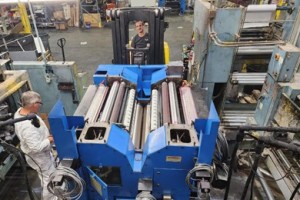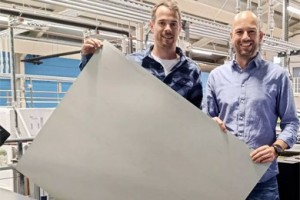Tassie tough: News' Hobart site in detail
Sep 01, 2009 at 12:13 am by Staff
There’s a steely self-sufficiency about life in Hobart, Australia’s southernmost city, recognising the fact that help may not be close at hand ...especially in the middle of the night, and with a daily newspaper to produce, writes Peter Coleman.
So a new plant for News Limited subsidiary Davies Brothers Limited primarily to print ‘The Mercury’ is built tough.
On the face of it, the combination of a KBA Comet single-width press with Ferag mailroom replicates that at the Murdoch-owned group’s Gold Coast ‘Bulletin’, albeit on a smaller scale. But a raft of design differences address the fact that the Taswegian capital is closer to Antarctica than it is for example, to Cairns or Perth, and has no major industry suppliers or their engineers represented in the state. At 11°C the day GXpress visited, the climate had more in common with the icy continent as well.
Full redundancy – the knowledge that there’s a spare for anything that might break, virtually regardless of how big – delivers massive security and comfort for the state’s largest-circulation daily newspaper. An unusual double-delivery folder and a second Ferag RollSert inserting drum are dedicated to this cause, duplicating the key components in the system without providing additional capacity.
Nor was the $32 million-worth of new kit, which went on edition in mid-May, operational a moment too soon: The folder on the 35-year-old Goss Urbanite it replaces – relocated to Hobart from Melbourne’s Leader Newspapers in 1993 – “threw a wobbly” on what is likely to have been its last performance before being scrapped.
Production manager Wayne Bailey says the old press, which had eight mono and two tricolour units to print a maximum of seven webs was “well past its use-by date”. Production of more than an 80-page product was unreliable: “Every night we would be lifting and packing blankets and plates to chase registration,” he says.
All of that has now changed with the commissioning of the new press: The six-tower Comet has six of the maker’s Pastoline rollstands at right-angles to the pressline, with the double-delivery KF 3B jaw folder at the centre. One folder delivery has quarterfold, and the other stitching, while Planatol gluing is installed ahead of the single former.
KBA’s own systems replace the EAE controls and Amal pasters of the Gold Coast Comet, and there is also PATRAS roll handling.
Rated at up to 75,000 cph straight production, the single-width press has a cut-off of 578 mm and runs an 810 mm web within a design range of 630-870 mm. The two KBA control consoles feature EAE’s Print PP job scheduling and press presetting software, a RIP interface to accept prepress data, and a diagnostics PC for remote maintenance.
Ancillary equipment includes Baldwin’s Impact blanket washers – which use pre-impregnated cleaning cloths – and Constant C-based spray dampening. Pumped ink (Flint) is delivered from two-tonne bulk tanks and one-tonne totes using a Technotrans system.
Two Agfa Polaris XC-V platesetters from the city plant have now been relocated in the new quiet room, and a Barenschee VSAK 240C optical plate bender added to the line.
Bailey says Agfa’s Opti-Ink ink optimisation software has been in use since the press start-up, with good results, and while there are no immediate plans to implement the Sublima hybrid stochastic screening, he’s interested in doing so. For one thing, it would solve the problem of moiré in real estate pictures which has recurred with that section being brought inhouse.
Self-sufficiency also means the ability to print the entire product inhouse, bringing to an end the outsourcing of 40 per cent of ‘Mercury’ production from Fairfax Media’s ‘Examiner’ (Rural Press Printing) site in Launceston, and from PMP Print across Bass Strait in the Melbourne suburb of Clayton.
Print runs are 51,000 copies for the 154 year-old ‘Mercury’ on weekdays and 80,000 at weekends, plus 60,000 of the ‘Sunday Tasmanian’. Products typically vary in size from 40-64 pages plus a variety of supplements including a real estate guide of up to 72 pages. There’s also the DBL-owned ‘The Gazette’ for the Derwent Valley to print, and a small amount of commercial work.
The Comet press prints a tabloid product of up to 96 pages (collect) all in colour, stitched separately or in sections, or can equally well turn out inline-glued quarterfold products – such as Sunday’s ‘TV Guide’ – of up to 64 pages.
Arrangement of the folders – which share a single former – one in front of the other was a “less expensive option” which group technical manager Barry Johnson says required less space and allows both tabloid deliveries to be served by a single Ferag pick-up station. Another pick-up serves the quarterfold delivery of the front folder.
Downstream, a gripper-conveyor system can deliver copies to the first or second Ferag RollSert inserting drum (but not both) – ahead of RollStream precollating systems each of which have six manual feeders – or to UTR delivery, with SNT-U three-side trimming also inline.
The downside is that with no buffering, the inserting system stops and starts with the press, and – as happened during my visit – can lead to a press shutdown if there’s a snarl-up in the mailroom ... but it’s a problem they’ll soon overcome.
In the meantime, Bailey urges restraint with the ‘speed up’ button: Echoing a Tasmanian road safety slogan, he points out that the Comet’s 40,000 cph rated speed (collect) is “a limit, not a target”.
Most nights there are leaflets or preprint sections to insert, although the press is big enough to print typical weekday editions collect in one run, and the mailroom operation is still highly labour-intensive with a number of single copies rolled for newsagents in outlying areas. Davies Brothers is also Tasmania’s major newspaper distributor.
A major benefit of the plant upgrade is the availability of back-to-back colour throughout – compared to the 16 pages of process on the old Urbanite in a maximum product of 80 pages – and the amount of outsourced production which has been saved. This includes the quarterfold TV Guide, a rural supplement, Friday’s Property Guide and at least 32 pages of Cars Guide (and additional pagination) in Saturday’s paper.
From a marketing point of view, the new press and mailroom bring capacity to print editorial and advertising colour on any page – including classified advertising, normally part of the main book – plus improved lead times from eliminating hand inserting.
The property section – which runs to 64-72 pages on 55 gsm > Turn to page 16
> From page 15 Norstar 80 improved newsprint – had been printed heatset by PMP and Bailey admits there was an initial reaction by real estate agents to the coldset product. “Some of the corporate colours changed slightly, but we’re adjusting that ... and they’re getting used to it,” he says.
The Glenorchy press crew is also smaller than on the Urbanite in Argyle Street, four printers having taken redundancy at the changeover. Bailey says the intention had been to offer roles at the new plant to everyone, including casual publishing and inserting staff, until cuts were driven by the economic situation.
Announced in mid-2007, the project began with construction of the building – at the entrance to the Glenorchy Technopark and overlooking the Derwent river – the following March. The site is secured by two sets of steel gates and strategically placed beside the main roads network and Tasman bridge. It is also close to the Norske Skog newsprint mill.
Bailey says that while there were some delays with completion of the building, installation of the press went to schedule.
The Sunday night ‘go live’ was a textbook affair and followed training for half the printers in the final fortnight of the installation. Plates were made at both sites and two printers stood by on the Urbanite, but with no problems on the new press, “we told the guys to come have a look,” he says. “By the third day, we were making use of the extra editorial colour, albeit on pages which we could switch back to mono if we had to.”
They didn’t ... and the previously-outsourced work was taken in over the next couple of weeks, ending with the real estate supplement and TV Guide.
Bailey pays tribute to the support of the KBA mechanical and electrical engineers over a three-week handover, and to the News Limited technical team including production director George Calvi, group technical manager Barry Johnson, technical mechanical engineer Wayne Murphy and project manager Peter Williams.
“Their effort and experience made the project so successful and on time,” Bailey says.
Family links tie Bailey to the Mercury
Production manager Wayne Bailey is not only ‘born and bred Tasmanian’, he also has close family links with the ‘Mercury’: His father and three uncles worked in editorial – one as a cartoonist – and his cousin Gary Bailey is the newspaper’s current editor.
Bailey (49) joined the company in 1976 as an apprentice compositor, by which time the hot-metal linecasters were being driven by paper tape, and soon found himself in the systems room amid Linotype-Paul hyphenation and photocomposing systems. “I trained myself on an Apple Mac programme from Pongrass called AdSpeed, trained colleagues, and not long after was appointed prepress manager,” he says.
He became production and IT manager when Roger Harrison left four years ago.
Finally, the Australian's 'distribute-and-print' model cuts through the fog
The ‘distribute-and-print’ model espoused by digital newspaper printing system vendors has been a reality in Australia since Rupert Murdoch launched the ‘Australian’ in 1964.
And a further piece has been put in place with the upgrade of print plant at Davies Brothers Limited in Hobart. Previously, copies airlifted from Melbourne carried a freight surcharge of 40 cents on the normal weekday cover price of $1.50.
After a successful trial for the ‘Australian’ at the end of June, local production in Tasmania began on August 17, with the ‘Weekend Australian’ set to start on September 5. The national broadsheet calls for about 4500 copies there through the week and 12,000 of its Saturday edition.
There are also plans to print the 9000 copies of Melbourne’s ‘Herald Sun’ and 11,000 ‘Sunday Herald Sun’ sold in Tasmania. Both will require preprint runs on some days, while broadsheet editions on other days will be divided into two equal sections. Height restrictions on the Glenorchy building ruled out the possibility of the upper former needed to further sectionalise editions.
Editions of the ‘Australian’ are now printed in Sydney, Melbourne, Adelaide, Brisbane, Perth, Townsville and Hobart. Darwin will be the only capital to which copies are now airlifted.
When the new national newspaper was launched, stereo press plates for letterpress editions were cast from ‘flong’ moulded in Canberra and flown to other remote sites. Later, the prevalence of fog in the national capital led to its production centre being moved to Sydney.
Sections:
Newspaper production













Comments